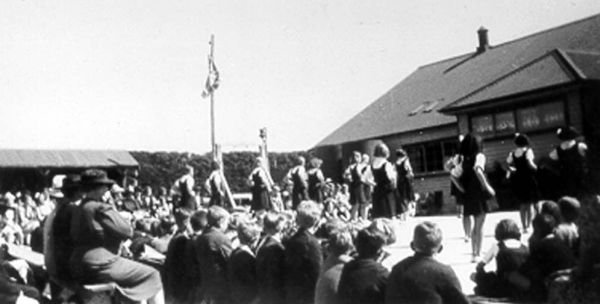 |
 |
|
Area Schools
Area Schools were an innovation in Australian rural education, although the idea had been brought back to Tasmania by the Director of Education, GV Brooks, after his visit to England in 1935. Like a number of other reforms in Tasmanian education, they arose largely as a way of coping with expanding demand on a severely limited budget. The aim was to redirect expenditure from the many inefficient small schools to larger ones in the towns, but not merely as a way of saving money. It was argued that the policy would lead to better facilities and an improved standard of schooling for country children, but in many ways the area schools went beyond this aim. They became the standard-bearers for new educational ideas. A policy of closing small schools and conveying their students by bus to larger centres had been introduced in 1924, but this had not been welcomed in many areas and progress was slow. What made the area school new, and more attractive to parents, was not merely the better facilities, but the provision of post-primary classes with a curriculum rich in citizenship and practical rural subjects, directly related to the character of their districts. The first two area schools were opened in Hagley and Sheffield in 1936 and despite some initial resistance, the rural districts enthusiastically embraced the idea, which in turn delivered the political support required for the extension of the programme. Two more were opened in 1937, another three in 1938, and four more in 1939: by 1960 there were 41. One indication of the success of the area schools was the fact that the older students were beyond the compulsory age: their attendance was a matter of choice. When the school-leaving age was raised to sixteen in 1946, the capacity to cope with increased classes was largely in place in the rural districts, but not in the cities. The 'modern schools' created to fill this void were in many ways an attempt to create an urban version of the area schools, but these failed to establish themselves. At much the same time the area schools also began to lose their appeal, and for much the same reasons. It was becoming increasingly apparent that the area schools, by preparing them so well for rural life, made it difficult for students to aspire to any career other than a farmer, or a farmer's wife. From the outset area schools had been non-academic: rural students aiming for tertiary education still had to leave home and board in the cities. The modern schools similarly closed off any hope of academic study. With the rapidly-expanding post-war economy, the notion that educational opportunities should remain open and available equally to all had become widely accepted, especially among parents. The area schools were progressively transformed into district (primary) schools, or district high schools, and the modern schools into high schools, all on the comprehensive principle. Michael Sprod
|
Copyright 2006, Centre for Tasmanian Historical Studies |
